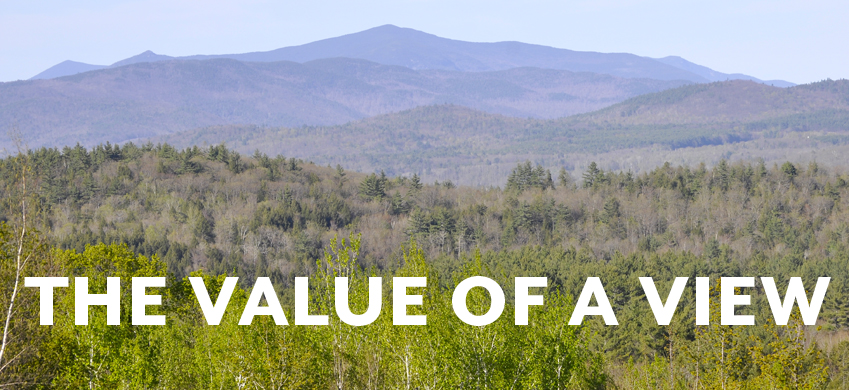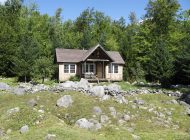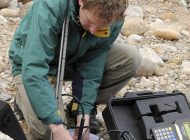A Center for the Environment pilot study investigates local residents’ attitudes on the value of scenic views.
by Marcia Santore
What is the value of a scenic view?
This year, the Groton Wind Farm came online with a row of 24 Gamesa G87 wind turbines planted atop a ridge in the town of Groton. Iberdrola Renewables, the Spanish company that built the wind farm, estimates that together the turbines will produce about 48 megawatts of electricity, enough to power 20,000 average New Hampshire homes. The turbines, each 256 feet tall with three 139-foot-long blades, are visible for miles around. For some people in this region, these huge turbines are a huge problem.
Proponents of renewable energy point out that wind is one of the United States’ many viable ways to reduce our dependence on foreign oil and produce electricity without the carbon emissions that lead to global climate change. The ability to produce wind power could be a valuable asset to the state. Opponents are concerned about another of New Hampshire’s valuable assets: its natural beauty. Do wind turbines detract from New Hampshire’s natural beauty? Or are the turbines themselves beautiful? Will the presence of turbines have a negative effect on tourism? Or is the presence of turbines, whether beautiful or ugly, a reasonable price to pay to move away from foreign oil and reduce global warming?
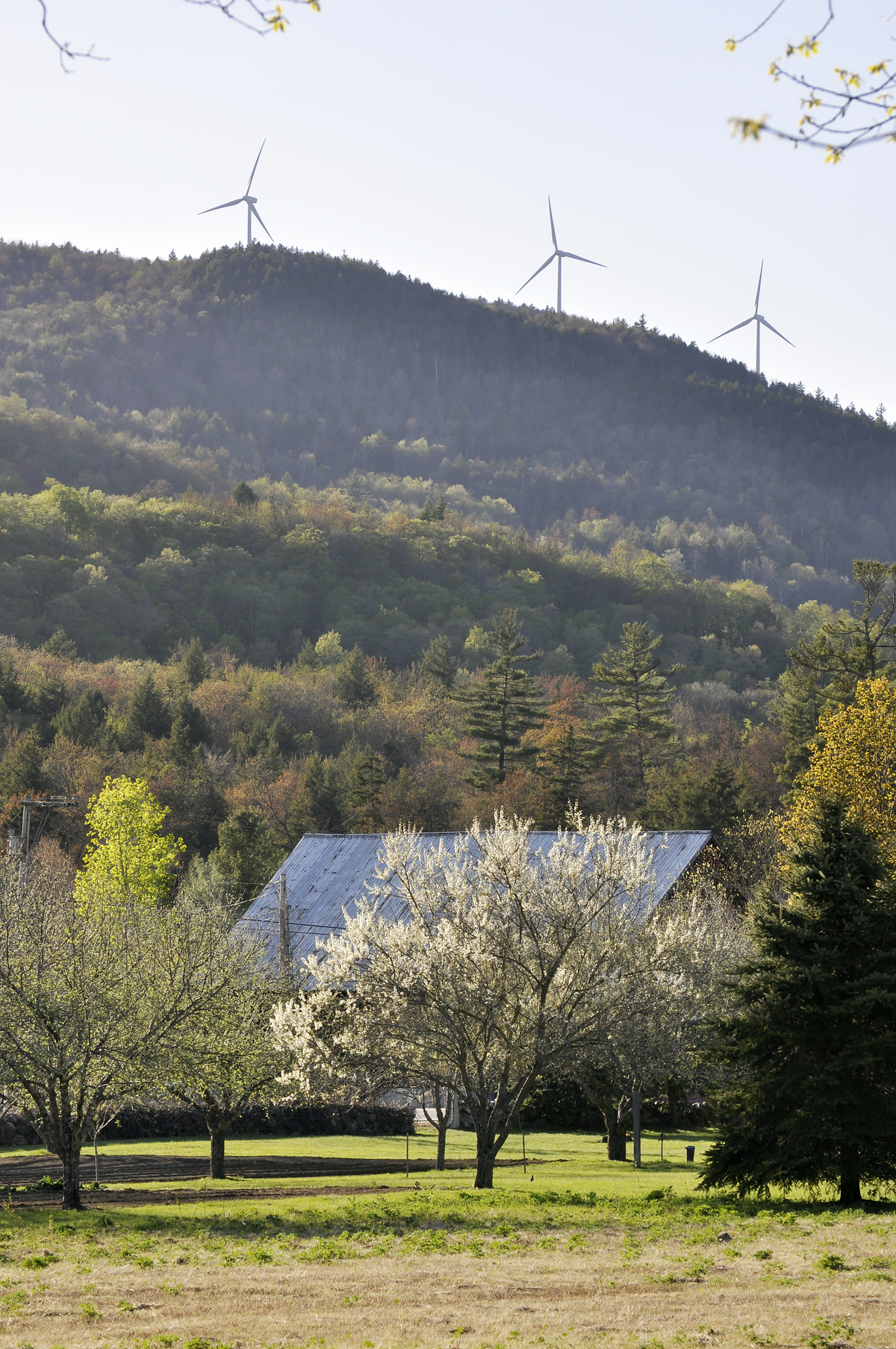
A viewshed is an area of land, water, or other environmental element that is visible from a fixed vantage point. Daphne Bruemmer '98 photo.
The answers to these questions are different for different individuals, based on each person’s values. This raises other questions: Should these values-based opinions affect policy decisions—decisions like granting or denying permits for wind farms or providing education to the community about renewable energy? How do we know what all those different values-based opinions are and how widespread each different opinion might be?
These are the kinds of questions that Professor Shannon Rogers, an ecological economist who joined PSU’s Center for the Environment in fall 2012, will address through her Viewshed Valuation Pilot Study, with the help of two environmental science and policy students and a grant from the National Science Foundation’s Experimental Program to Stimulate Competitive Research (EPSCoR). The EPSCoR grant is part of a larger effort within the Center for the Environment to build private funding for student research. “I think conducting research is integral to the educational process of our students,” Rogers says.
The term “viewshed” is used in fields as diverse as urban planning, archeology, and even military science. It refers to an area of land, water, or some other part of the natural environment that can be seen from public areas, such as a road or a park. The term usually indicates a place of scenic or historic value that is worthy of being preserved in its natural condition. The Groton Wind Farm, for instance, is placed on a ridge of hills that can be clearly seen from several locations in the area. The wind turbines are distinctly silhouetted against the sky—for good or ill, they definitely change the view.
In her research, Rogers uses a method called multicriteria decision making, which takes values into account as part of systematically looking at a decision-making process. The Viewshed Valuation Pilot Study will use this methodology to talk with stakeholders about the Groton Wind Farm as it relates to their attitudes and beliefs about such topics as energy, private property, natural beauty, property values, tourism, and the environment.
“I think we at the Center for the Environment are in a unique position, both because of our geography and our expertise, to help understand these viewshed issues,” Rogers says. “We are not taking a side; rather we would like to see what the underlying values are around these issues and how they might vary across the community.”
As Rogers described in her proposal to EPSCoR, this project uses an issue of viewshed management that is currently of concern to people in the area “to stimulate community dialogs about the variety of ecosystem services encompassed in a viewshed and their associated values, including both economic and non-economic values.” Unlike other visual impact assessments, this project investigates the underlying values that people have about views with the intention of developing data that can be helpful in decision making affecting both viewsheds and the environment.
Rogers spent a couple of months planning the project and developing a proposal for EPSCoR. The grant allows one undergraduate and one graduate student to serve as research assistants on the project; at the beginning of March, Ashley Hyde (a graduate student in the MS in Environmental Science and Policy program) and Rebecca Brown (an undergraduate Environmental Science and Policy major) began work on the pilot study.
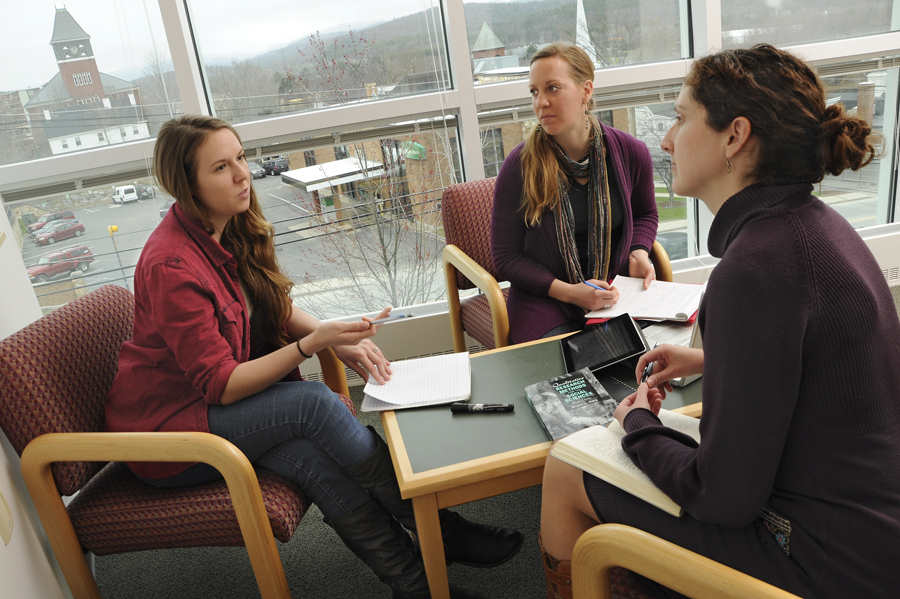
Rebecca Brown (left) and Ashley Hyde (center) discuss findings from their latest resident interview with PSU Professor Shannon Rogers. Jon Gilbert Fox photo.
Their first task was a literature review and latent content analysis. That means going over news reports, records of public meetings, and other documentation to identify repeating themes that reflect the current range of opinions. If many people are expressing some version of a particular value, it’s probably relevant. Using the information they found during this initial process, they worked with Rogers to design questions that reflect those themes.
“The literature review step to this study was really interesting,” Brown says. “It allowed me to learn more about viewsheds and the controversial issues around wind farms in particular. It’s exciting to interview members of the community to further understand the public’s opinion on this new technology. Hopefully our results will lead to a better understanding about the value of scenic views on a community level, which could be helpful in policy making in the future.”
“Based on our literature review,” says Hyde, “it’s clear that landscapes are viewed in a holistic way and that integration of ecological, economical, and social values are key to well-managed viewsheds. Social attitudes toward wind farms are an increasingly studied topic in Europe. The Not in My Back Yard (NIMBY) effect was a concept that surfaced often. NIMBY suggests that there is an attitude-behavior gap in which people support the idea of wind power but they do not support the idea of having wind farms in their ‘backyard.’ It seems as though the locals who are more likely to support wind farms are those who were involved in a ‘fair’ planning process and had ownership in the project from the beginning development stages.”
Hyde attended the North Country NH Listens discussion in Plymouth in March as part of this preliminary work. “We are only beginning to scratch the surface of local attitudes towards the Groton Wind Farm but currently there seems to be mixed support. The discussion revealed a strong desire to preserve New Hampshire’s natural assets for multiple interests.”
Brown and Hyde are identifying a small group of stakeholders—seven to 10 people with an interest in the topic from towns surrounding the wind farm, such as Groton, Rumney, and Plymouth. With help and oversight from Rogers, the students are conducting individual interviews with these stakeholders, asking the questions they’ve developed while leaving room for new topics to arise naturally in the course of conversation. If funding allows, Rogers would like to follow up the interviews with a community workshop that would take place over several hours and explore similar questions to generate even more ideas and perspectives.
Rogers and her team will use a qualitative analysis software called NVivo to draw out themes and summarize responses. Qualitative analysis is frequently used in the social sciences to analyze data that is difficult to put into numbers. Unlike quantitative analysis, which focuses on measurement for statistical, mathematical, or computational results, qualitative analysis helps researchers to interpret data from that hard-to-quantify and often contradictory factor: human beings.
Typically, qualitative research involves focusing on smaller groups, as in the Viewshed Valuation Pilot Study. Since the number of people being interviewed is relatively low, Rogers points out that these responses can’t be considered to represent the perspectives of everyone in the community but are useful in determining what the different perspectives are. Small pilot studies like this one are often used to generate the data needed to pursue larger, more comprehensive studies down the road.
“It’s the opportunity to pursue research like this that attracts students to Plymouth State’s program in Environmental Science and Policy,” says CFE Director and Professor Joe Boyer, who adds that in the past five years, the program has grown to 120 student-majors. “We’re hoping they will continue into the graduate program, which can lead to academic careers or better jobs in an agency or company. Our graduate students don’t only go back into academia but back into the community.”
Boyer notes that from its inception almost 10 years ago, the Center for the Environment has had a three-part focus: the environment, the economy, and the community. Projects like Rogers’s are a good example of that focus, bringing together academics from both science and sociology with partners in the community. “The value that the ecosystem provides to humans isn’t always captured in economic models,” he says. “Public perception plays into how we manage the land and water. What do people feel and how do you deal with it? It’s hard for scientists because it’s not clear cut. That’s where sociology, anthropology, and psychology come in.”
As a New Hampshire native, Rogers understands the attachment residents have to the scenic attractions of the state. She was raised in Strafford, between Concord and the Seacoast. Her studies at Dartmouth and UNH reflected her desire for an interdisciplinary approach to studying the environment, one that, she says, recognized that “humans are not separate from the rest of the world.”
When a former Dartmouth colleague told her about the opening for an ecological economist at PSU’s Center for the Environment, Rogers was excited at the prospect of working somewhere with a mission that so closely matched her interests, as well as the opportunity not only to stay in her home state, but to work at “a place that values place” she says, and to work with Boyer, who also came to Plymouth State for the beginning of the fall 2012 semester.
Projects like Rogers’s Viewshed Valuation Pilot Study, Boyer says, help “reinforce that connection between environment, economy, and community. Environmental decision making is complex because different groups care about different things. Actively engaging the community, even if the final decision wasn’t their chosen option, helps the public feel that the process was inclusive. You hope that if you have open-minded people involved in the process, they’ll consider all the options. Even adversaries can learn to respect each other during an objective review process.”
Tags: Center For the Environment environment Groton Wind Farm NIMBY tourism viewshed wind power wind turbines





